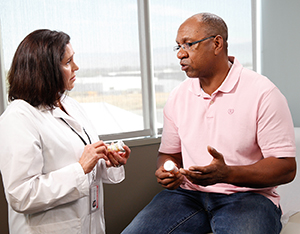A
B
C
D
E
F
G
H
I
J
K
L
M
N
O
P
Q
R
S
T
U
V
W
X
Y
Z
Click a letter to see a list of medical procedures beginning with that letter.
Click 'Back to Intro' to return to the beginning of this section.
Discharge Instructions for Aortic Valve Stenosis
You have been diagnosed with aortic valve stenosis. This means the aortic valve in your heart is stiff or remains in a near-closed position and has trouble opening. Because of this, your heart has to work harder to push the blood through the valve and out to the rest of the body. In some cases, this extra work makes the muscle of the heart thicken. The extra work can tire the heart and cause it to get weaker over time. This condition often changes very slowly and doesn't always need to be treated. But in some people, it may get worse faster and need to be treated.
Some of the more common symptoms that can be caused by aortic valve stenosis are dizziness, fainting, shortness of breath, or chest pain. Rarely, the stenosis can be treated with just medicines. Typically, when the stenosis is severe or is causing significant symptoms, surgery is needed. Surgery to repair or replace the valve may be done through a catheter. This is called transcatheter aortic valve replacement (TAVR). Or you may have open heart surgery. Your health care provider will advise which type of procedure is right for you.
Home care
-
Check with your provider before taking any over-the-counter medicines, herbal products, or vitamins.
-
Take your medicines exactly as directed. Don’t skip doses.
-
Keep all follow-up appointments. You may not have symptoms. Or you may need close follow-up and surgery. Or you may need TAVR.
Lifestyle changes
-
Stay at a healthy weight. Get help to lose any extra pounds.
-
Ask your provider if an exercise program is right for you. Some people with aortic stenosis need to be very careful about exercise because it can cause fainting.
-
Break the smoking habit. Enroll in a stop-smoking program to improve your chances of success.
Follow-up care
Make a follow-up appointment with your provider, or as directed.

Call 911
Call 911 if:
-
You have chest pain or shortness of breath.
-
You have weakness in the muscles of your face, arms, or legs.
-
You have trouble speaking.
-
You have a rapid pulse or pounding heartbeat.
-
You have fainting or dizziness.
-
You have sudden vertigo.
Online Medical Reviewer:
Stacey Wojcik MBA BSN RN
Online Medical Reviewer:
Steven Kang MD
Online Medical Reviewer:
Terri Koson DNP RN ACNP
Date Last Reviewed:
2/1/2025
© 2000-2025 The StayWell Company, LLC. All rights reserved. This information is not intended as a substitute for professional medical care. Always follow your healthcare professional's instructions.